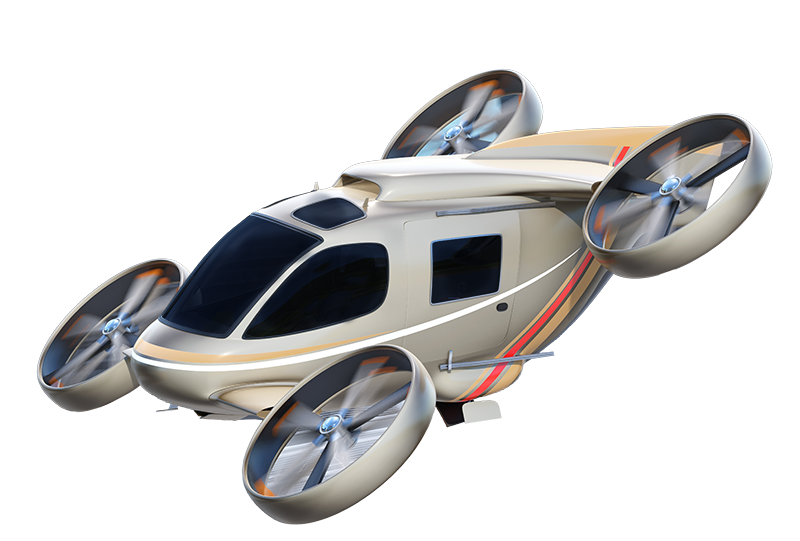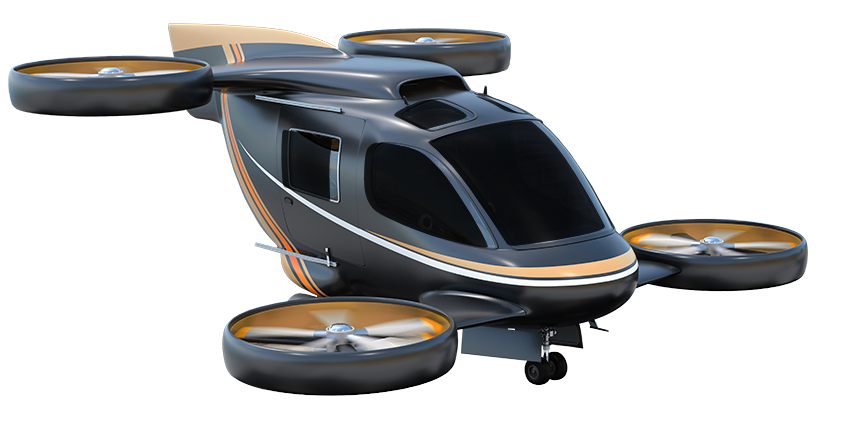The emerging advanced air mobility sector (AAM) promises to deliver huge benefits and capabilities to the aviation industry, including lower noise levels, less maintenance and zero fossil-fuel emissions. In anticipation of this coming tectonic shift, what are industry and government entities doing now that will help pave the way to safe operations?
Safe introduction of AAM into the U.S. aviation system requires coordination of an entire ecosystem of moving parts. Aircraft certification, operations and pilot training, airport infrastructure and airspace integration are just a few of the areas experts are working to address before AAM operations kick off.
Here are some of the initiatives underway to ensure a path to safe AAM operations.
Aircraft Certification
Many of these aircraft will be electric vertical takeoff and landing aircraft (eVTOL). The FAA considers these aircraft to be “powered-lift.” There are no airworthiness standards directly applicable to powered-lift aircraft. As a result, most aircraft used in AAM will be considered “special class,” certificated under 21.17(b). However, “special class” does not mean preferential treatment. In fact, a special class certification project actually goes beyond normal certification standards, which are pretty broad.
“Special class recognizes that the FAA can draw from all airworthiness standards, combine those standards as appropriate for that specific project and add additional requirements, which could be considered under ‘special conditions’ for other aircraft,” said Walter Desrosier, vice president of engineering and maintenance at the General Aviation Manufacturers Association (GAMA).
For a typical aircraft certification process under normal airworthiness standards, unique design characteristics are certified through special conditions, which go through the full rulemaking process, including public comment.
“For these aircraft certificated under 21.17(b) as special class, there’s a different level of transparency and scrutiny,” said Desrosier, who explained a special class aircraft’s entire airworthiness standard will go through rulemaking and will be published for public comment. “Published 14 CFR airworthiness standards do not go out to public comment for each normal-category aircraft. The airworthiness criteria for each special class aircraft do.”
Although going through the entire rulemaking process simply to determine airworthiness criteria can slow manufacturers’ progress, there are benefits to seeking public comment. Desrosier says many experts from industry and other aviation authorities have provided input into the two special class airworthiness standards published to date – the Joby Aviation JAS4-1 and Archer Aviation M001.
Much has been made of where AAM aircraft will fall in the FAA’s traditional safety continuum. Desrosier reports the safety continuum philosophy, which is based on risk and societal expectations of safety, has greatly improved safety in GA aircraft. However, simply setting the highest design standard in one area does not necessarily provide the desired outcome, which is a safe operation.
The design of the aircraft, the technology of the aircraft, the type of operations, as well as who operates the aircraft and the environment in which the aircraft will operate, are all key considerations in determining the appropriate application of the safety continuum. The certification processes currently underway consider these variables.
Operations and Pilot Qualifications
The FAA’s 2022 determination that these aircraft are powered-lift created a bit of a regulatory quandary, as powered-lift aircraft are not referenced in many operations or pilot qualifications regulations. Industry experts and the FAA are working to determine operational and pilot training requirements, as well as best practices.
The FAA recently published an NPRM to update air carrier definitions, allowing powered-lift operations to conduct commercial operations under Part 119. Soon, the FAA will publish a Special Federal Aviation Regulation (SFAR) proposal to further describe operational rules for powered-lift aircraft, presumably for Part 91 and 135 rules, among others. The SFAR will also describe pilot training and qualifications requirements.
 “Until we have a clearer, better-defined picture of what the world will look like upon entry into service, our ability to shape pilot training and develop operational policies is limited,” said Paul McDuffee, senior manager of regulatory policy at Supernal. “Entry into service for most AAM operations will be in piloted aircraft. Still, there’s much work to be done in coordination with regulators and airspace managers.”
“Until we have a clearer, better-defined picture of what the world will look like upon entry into service, our ability to shape pilot training and develop operational policies is limited,” said Paul McDuffee, senior manager of regulatory policy at Supernal. “Entry into service for most AAM operations will be in piloted aircraft. Still, there’s much work to be done in coordination with regulators and airspace managers.”
In the meantime, aircraft manufacturers and future operators are working behind the scenes to evaluate their own aircraft and training needs, utilizing simulators to evaluate training techniques.
Once operations begin, commercial AAM flying will likely be conducted under Part 135, meaning the recent NPRM mandating safety management systems (SMS) for Part 135 operators will apply. This sets a level playing field for safety management across all segments of Part 135 operations.
Airport Infrastructure
It is likely AAM operations will launch at existing airports and heliports, as acknowledged in the FAA’s NPRM updating air carrier definitions. The aircraft will operate similar to helicopters when in these environments, though specific requirements are unknown until the SFAR is published.
As AAM operations increase in frequency and scale, vertiports will be developed to support operations.
The FAA published Engineering Brief (EB) 105 in 2022 to provide interim guidance related to ground infrastructure development. The EB outlines initial guidance for vertiport standards for facilities serving aircraft with a maximum gross weight of 12,500 pounds or less that utilize electric propulsion. The FAA Office of Airports is developing a new vertiport Advisory Circular (AC) to establish more permanent requirements for new vertiport infrastructure, which is expected to be published in 2025.
These guidelines for infrastructure development, coupled with the upcoming operational regulations, will ensure safe operations in the airport, heliport and, eventually, vertiport environment.
Airspace
How will these aircraft operate and integrate into the National Airspace System (NAS)?
For initial operations, the only real consideration is whether the aircraft will operate under airplane or helicopter rules, which should be determined by the upcoming SFAR. No significant changes are necessary for piloted operations at the scale expected at initial entry to service.
 “We intend to operate in the same world we do today, using the same principles and tenets of good, safe legacy aircraft in the NAS,” said McDuffee. “That’s the industry expectation now and in the future.”
“We intend to operate in the same world we do today, using the same principles and tenets of good, safe legacy aircraft in the NAS,” said McDuffee. “That’s the industry expectation now and in the future.”
Jeffrey Vincent, now the executive director of the FAA’s Office of Drone Integration, formerly the vice president for Air Traffic Services, does not anticipate any concerns with AAM integration into the NAS, at least during initial operations. At a recent NBAA News Hour, Vincent expressed his confidence that the current NAS can accommodate these aircraft.
“We don’t have to come up with a new air traffic system to accommodate advanced air mobility vehicles,” Vincent said, although he acknowledged there is work to be done before AAM reaches full-scale operations and particularly before autonomous aircraft enter the NAS at scale.
As aircraft evolve to more automated operations and the frequency of flights increases, airspace integration policies will also need to continue to evolve.
International Considerations
The International Civil Aviation Organization (ICAO) addresses powered-lift airman certification requirements as well as operational requirements in its Standards and Recommended Practices (SARPs) and guidance materials.
For pilot certification, ICAO SARPs state a pilot with an airplane or helicopter category rating may receive type-specific training in a powered-lift and add a powered-lift type rating to that existing license (“certificate” in the U.S.). That pilot is then qualified to fly that specific powered-lift aircraft type.
The type rating concept for qualifying pilots allows aviation authorities to have a transition period to qualify powered-lift pilots, but prevents “privilege creep” that could occur if authorities were to require only a broad powered-lift category rating. A powered-lift category rating, theoretically, would allow a pilot to fly any powered-lift aircraft. The powered-lift aircraft currently under development, though generally rather simple to fly, are too dissimilar for a standardized pilot qualification.
ICAO also addresses powered-lift operations through its Guidance Document 10010, which directly applies to tilt-rotors but is more broadly applicable to powered-lift aircraft. The guidance essentially says powered-lift should utilize helicopter rules in most cases, except where airplane rules make more sense. For example, powered-lift aircraft are capable of gliding on the wing, so airplane overwater rules are more appropriate for powered-lift than are helicopter rules. Conversely, because the powered-lift aircraft are highly maneuverable and are capable of taking off and landing vertically, helicopter rules are more appropriate for minimum altitudes, airport operations and weather minimums.
These two documents, developed by industry experts and aviation authorities worldwide, lay the groundwork for safe operations, allowing ICAO member states to develop their own regulatory regimes for AAM within the ICAO framework.
Going For Gold: AAM at the Olympic Games
AAM operations might be a reality sooner than you think. Organizers of both the 2024 Summer Olympic Games in Paris and the 2028 Summer Olympic Games in Los Angeles hope to feature AAM as part of the transportation offerings during those events. While the scale of the 2024 operations might be limited, by 2028, AAM could be a real player in the transportation of athletes and spectators.
Industry and federal, state and local agencies are working together to ensure a safe path for those operations.
NBAA is also doing its part by providing critical links between emerging technologies, including AAM, and legacy operations. One association initiative, the NBAA AAM Roundtable, is a forum for policy planning and operations integration. The roundtable provides a voice for manufacturers developing eVTOL aircraft and related infrastructure with regard to airport access, airspace management, local community engagement and other priorities and is an important connection to NBAA’s traditional membership.



 International Business Aviation Council Ltd.
International Business Aviation Council Ltd.